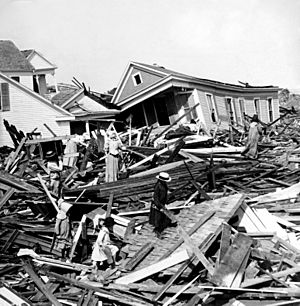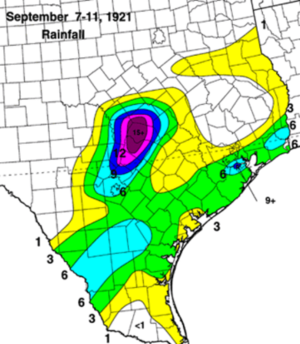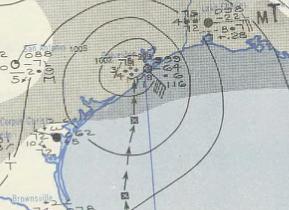List of Texas hurricanes (1900–1949) facts for kids
The List of Texas hurricanes from 1900 to 1949 tells the story of 47 tropical storms and hurricanes that hit the U.S. state of Texas. The year 1933 saw the most storms affect Texas, with five different systems. Some of the most powerful storms during this time were the 1900 and 1915 Galveston hurricanes. The 1900 storm was especially tragic, causing between 8,000 and 12,000 deaths. Another notable storm was the 1943 Surprise Hurricane, which killed 19 people because weather information was kept secret during World War II.
Contents
Hurricanes from 1900 to 1909
- September 9, 1900 – The 1900 Galveston hurricane hit Galveston Island as a very strong Category 4 hurricane. This storm is known as the deadliest natural disaster in United States history. It killed an estimated 6,000 to 12,000 people. Much of the damage happened in Galveston, which was mostly destroyed by a 15-foot (4.6 m) storm surge. All homes in Galveston were damaged, and 3,636 were completely destroyed. Many public buildings and churches were also damaged or ruined. The storm caused about $30 million in damage in the city. About 10,000 people in Galveston lost their homes. This was about a fourth of the city's population. Areas around Galveston were also badly hit, with $3 million in damage. Some towns lost all their homes and buildings. After the storm, Galveston changed a lot. The city government changed, 2,146 buildings were lifted higher, and a 6-mile (9.7 km) long, 17-foot (5.2 m) high seawall was built.
- July 10, 1901 – A tropical storm hit near Matagorda with winds of 50 mph (80 km/h). Strong winds reached San Antonio. High tides flooded streets in Galveston. A few homes in Galveston were washed away. Small boats and marinas in Port Lavaca were damaged.
- June 26, 1902 – A hurricane moved along Padre Island before hitting Port Lavaca as a strong tropical storm. Strong winds damaged buildings in Edna, El Campo, and Franklin. Heavy rain caused flash flooding in East Texas. Nacogdoches had a record amount of rain for June. Flooded creeks covered the south side of that city.
- July 26, 1908 – A tropical storm formed near the Texas coast and then moved into Louisiana. This storm brought 3 inches (76 mm) of rain along Texas' eastern border.
- September 18, 1908 – A strong tropical storm came close to the Texas coast but broke apart before reaching land. Rain and strong winds hit Galveston, flooding streets and breaking windows. Phone and telegraph services in the city were also interrupted.
- June 29, 1909 – A Category 2 hurricane hit the Brownsville area with 100 mph (160 km/h) winds. It caused $113,000 in damage. Several buildings in the Rio Grande Valley fell apart because of the winds. Heavy rains, up to 6 inches (150 mm) in Llano Grande, caused the Rio Grande to swell more than it had in five years. Many people had to leave their homes. Other nearby rivers and lakes also overflowed.
- July 21, 1909 – The 1909 Velasco hurricane hit Velasco as a Category 3 storm. It caused $2 million in damage and killed 41 people. Damage happened all over southeastern and central Texas. Many crops were lost, and trees were knocked down. In Velasco, a 20-foot (6.1 m) storm surge destroyed most of the city, leaving only eight buildings standing. The hurricane's effects reached far inland, bringing heavy rain and strong winds to Central Texas. In Austin, where roofs were torn off homes, people said it was the worst storm they could remember.
- August 27, 1909 – The 1909 Monterrey hurricane brought rough waves to the South Texas coast. The storm surge flooded Port Isabel. It destroyed most buildings on Tarpon Beach near Corpus Christi, where winds reached 66 mph (106 km/h). Low areas of Corpus Christi were covered by 1 to 3 inches (25 to 76 mm) of water, especially north and northwest of the city along Nueces Bay.
Hurricanes from 1910 to 1919
- August 31, 1910 – A tropical storm moved inland over Mexico, just south of the Rio Grande. It caused some property damage in Brownsville and Port Isabel.
- September 14, 1910 – A hurricane hit the South Texas coast. Padre Island was completely covered by the storm surge. The southern parts of the island had winds of 120 mph (190 km/h). Winds of 61 mph (98 km/h) were felt farther north in Corpus Christi. Heavy rain fell across the Rio Grande Valley, setting some 24-hour rainfall records and causing minor damage.
- October 16, 1912 – A Category 2 hurricane crossed a quiet part of Padre Island between Corpus Christi and Port Mansfield. A 6-foot (1.8 m) storm surge combined with very high tides caused serious damage along the coast. Buildings were washed away, and $28,000 in damage occurred. The ship Nicaragua sank east of Padre Island, and six crew members were lost.
- June 28, 1913 – A weak hurricane, the first of 1913, hit southern Texas. The worst flooding was in Montell, where 20.60 inches (523 mm) of rain fell. This set a state record for the most rain in 24 hours. The floods washed away houses and cut off communication. One person drowned in the Montell area.
- August 17, 1915 – The 1915 Galveston hurricane hit San Luis Pass as a Category 4 hurricane with winds of 145 mph (233 km/h). It killed 275 people. The storm surge reached 16.2 feet (4.9 m), with waves over 20 feet (6.1 m) high. Galveston's new seawall helped prevent a disaster like the 1900 hurricane. However, parts of the city and Galveston Island not protected by the seawall saw many homes completely destroyed. Coastal cities along Galveston Bay were ruined by the storm surge. Strong winds and heavy rain across East Texas badly affected the cotton crop. Flooding rivers made the situation even worse.
- August 6, 1916 – A tropical storm moved inland just south of the Texas–Mexico border. It brought 50 mph (80 km/h) winds along the South Texas coast.
- August 16, 1916 – South Texas was hit by a fast-moving Category 4 hurricane, causing widespread damage. The Corpus Christi area was hit hardest, with winds reaching 90 mph (140 km/h). The city's waterfront areas suffered the most damage, including the loss of all docks and other coastal buildings. Significant destruction happened in nearby towns like Aransas Pass, Rockport, and Kingsville. The damage cost $1.8 million, and 20 people were killed.
- August 6–7, 1918 – The first Atlantic tropical storm of 1918 passed over East Texas as a tropical storm. It had hit Louisiana near the Sabine River as a major hurricane. Rain totals of 2–3 inches (50–75 mm) were recorded along the Texas-Louisiana border. The storm's heavy rains reached as far west as Crosby. Winds reached about 60 mph (97 km/h) in Sabine. The storm knocked down all telegraph lines east of Mauriceville and stopped train service.
- September 14, 1919 – The 1919 Florida Keys hurricane hit just south of Corpus Christi, Texas as a Category 3 storm. Heavy rain was common across southern Texas, with many places setting daily rainfall records. The storm killed 310 people in Texas (284 in Corpus Christi), but the total number of deaths might have been as high as 600.
Hurricanes from 1920 to 1929
- September 21, 1920 – The edges of a hurricane hitting the Louisiana coast brought rain to northeastern Texas. Beaumont received a maximum of 1.2 inches (30 mm) of rain.
- September 7–11, 1921 – The remains of a weak hurricane moved north into Texas after hitting just south of Tampico, Mexico. This caused major flooding in Central Texas. A record 40 inches (1,000 mm) of rain fell in Thrall over three days, with 32 inches (810 mm) falling in just 12 hours. This set a new national record for 12-hour rainfall. Overflowing rivers and streams flooded large areas, destroying crops and property. The flooding caused at least $19 million in damage and killed 215 people, making it the deadliest flood in Texas history. Parts of San Antonio were covered by floodwaters 7 feet (2.1 m) deep. The San Antonio Express-News called it the city's worst disaster. 51 deaths happened in San Antonio. Along the Little River, 159 people drowned.
- June 16, 1922 – Rain from a tropical storm caused heavy flooding along the Rio Grande. The river rose 29.6 feet (9.0 m) above flood stage at Eagle Pass. Downstream flooding covered many towns in Cameron and Hidalgo counties. Crops suffered $2 million in damage.
- September 7, 1925 – A tropical storm hitting just south of the Texas–Mexico border brought strong winds and rain to parts of South Texas. It also caused a storm surge along Padre Island. Winds in Corpus Christi reached 42 mph (68 km/h). Near Brownsville and Port Isabel, widespread flooding stranded cars and stopped transportation.
- September 8, 1928 – A tropical storm moved inland into Mexico south of the Texas border. This led to stormy conditions along the Texas coast up to Corpus Christi, where winds of 35 mph (56 km/h) were recorded.
- June 28, 1929 – A small Category 1 hurricane hit southwest of Port O'Connor. It caused $675,000 in damage and killed three people, all in Wharton County. Winds in Port Lavaca were estimated at 80–90 mph (130–140 km/h). Because the storm was small, the damage was limited to a narrow area. Power poles, signs, trees, and small buildings were knocked down by the strong winds.
Hurricanes in the 1930s
The first storm of 1931 hit the Galveston area as a tropical storm.
In 1932, the 1932 Freeport hurricane formed on August 11 in the southern Gulf of Mexico. It quickly grew from a Category 1 to a Category 4 hurricane in less than a day, with winds estimated at 140 mph (230 km/h). It slammed into the Texas coast near Freeport two days later. The eye of the storm crossed the coast around 10 p.m. on August 13. It created a 30- to 40-mile (48 to 64 km) wide path of destruction across Brazoria County, Texas. Official warnings for the storm came only 4 hours before it hit. Many people trying to leave had to abandon their cars in the strong winds and heavy rains. The 1932 hurricane stayed strong even miles inland and killed 40 people. The town of West Columbia, Texas, had the most deaths, with 7 people killed. Winds over 100 mph (160 km/h) flattened homes there. Two neighborhoods built for oil workers were completely wiped out. Freeport, Angleton, and Galveston had a lot of wind damage. Inland towns like Brazoria, West Columbia, Damon, and Needville, which were in the storm's path, were also ruined. Damage costs were over $7 million in 1932.
Texas had a lot of storm activity in 1933. The second storm hit Mexico after threatening Texas. The fourth storm hit near Matagorda Bay in Texas as a 45 mph (72 km/h) tropical storm on July 23. The fifth storm hit near Brownsville, Texas on August 5 as a strong tropical storm. This storm brought strong winds and high tides along the Texas coast. Heavy rains in south Texas and northern Mexico caused a lot of damage. High tides from the storm covered parts of South Padre Island. The tenth storm also threatened Texas, causing tropical storm warnings to be issued for parts of the southern Texas coastline. The eleventh storm hit just north of Brownsville early on September 5. It killed 179 people and caused $28 million in damage.
In 1934, the third storm was a Category 1 hurricane that passed over north Florida as a tropical storm and then hit central Texas. It caused 11 deaths and $1–$2 million in damage. The fifth storm was another Category 1 hurricane that passed close to Galveston.
The third storm of the 1936 season caused severe crop damage in San Patricio and Nueces Counties. In total, this hurricane caused $550,000 (in 1936 money) in damage, mostly to oil refinery property. However, no deaths or injuries were reported. The fourteenth storm of the season hit near Brownsville.
The third and fifth storms of 1938 both hit the state of Texas.
Hurricanes in the 1940s
- August 7, 1940 – The 1940 Louisiana hurricane hit the Texas/Louisiana border. It then weakened and disappeared three days later over Missouri. One person died, and $1.7 million in damage from flooding was caused by this hurricane.
- September 11, 1941 – Tropical Storm One hit the Texas coast between Galveston and Port Arthur. The storm disappeared the next day without causing any damage.
- September 23, 1941 – The 1941 Texas hurricane hit Texas east of Bay City as a major hurricane. It moved northward and became a non-tropical storm later that day. The hurricane caused heavy flooding in Texas, leading to $7 million in damage (in 1941 money) and 4 deaths. Houston was especially hard hit with winds up to 77 mph (124 km/h). Three people died, and power was knocked out in some parts of the city. Glass windows in downtown stores were shattered, and 15 truckloads of broken glass were removed after the storm.
- August 23, 1942 – Hurricane Two hit near Crystal Beach. It disappeared two days later over southern Missouri. The hurricane caused about $600,000 in damage.
- August 30, 1942 – The 1942 Matagorda hurricane hit the central Texas coast near Matagorda. It then disappeared over northwestern Texas. This storm caused $26.5 million in damage and eight deaths. Wind damage was reported as far inland as San Antonio.
- July 27, 1943 – The 1943 Surprise Hurricane was first noticed on July 26, 1943. The United States was in the middle of World War II, and there were no satellites or weather radar. Because of fears of German U-boats in the Gulf, all radio messages from ships were stopped, including storm reports. Newspaper articles mentioned a tropical storm in the Gulf of Mexico but did not say how strong it really was. The storm hit Bolivar Peninsula on July 27, crossed Galveston Bay, and then hit land a second time near the Houston Ship Channel. Because of war interests, there were very few warnings, and people were caught off guard. Winds were estimated at nearly 100 mph (160 km/h), with even stronger gusts. Damage was significant and mostly caused by wind. The storm killed 19 people and caused $17 million (in 1943 money) in damage to the Houston area. After the lives lost in this storm, weather information has never been kept secret again.
- July 22, 1945 – The Tropical Storm Two hit South Texas, causing strong winds and rough seas.
- August 28, 1945 – The 1945 Texas hurricane hit Port O'Connor with winds of 110 mph (180 km/h). The storm caused flooding across much of the coast, with an estimated 30 inches (760 mm) of rain. Port Lavaca was covered by a 15-foot (4.6 m) storm tide. The coastline moved back as much as 50 feet (15 m) in some places because of the storm. The hurricane caused three deaths and about $20 million in damages.
- June 16, 1946 – Tropical Storm One moved ashore near the Texas/Louisiana border, causing no damage.
- August 2, 1947 – Tropical Storm One hit Port Isabel with 40 mph (64 km/h) winds, causing heavy rain. Rainfall reached 9.78 inches (248 mm) at Raymondville. The storm caused one death and $2 million in damages. However, the rain helped many crops in East Texas.
- August 2, 1947 – Hurricane Three hit Galveston as a weak hurricane. It mainly caused wind damage to many buildings. The hurricane caused one death and $2 million in damages.
- October 3, 1949 – The 1949 Texas hurricane hit near Freeport with winds of 135 mph (217 km/h). It had crossed into the Gulf of Mexico from the Pacific Ocean. Before the storm, 50,000 people went to shelters. Rainfall reached 14.5 inches (370 mm) in Goodrich. The hurricane caused severe crop losses in the area. Power outages also happened across the region, with the entire city of Freeport losing power. The storm killed two people and caused $6.7 million in damages, mostly from lost crops.
Storms by Month
| Month | Number of storms |
|---|---|
| June |
8
|
| July |
7
|
| August |
16
|
| September |
13
|
| October |
3
|
Deadly Storms in Texas
This is a list of tropical storms and hurricanes that caused known deaths in Texas during this period.
| Name of Storm | Year | Number of Deaths |
|---|---|---|
| Galveston | 1900 | ~8,000 |
| Galveston | 1915 | 275 |
| Unnamed | 1933 | 179 |
| Velasco | 1909 | 41 |
| Freeport | 1932 | 40 |
| Texas | 1916 | 20 |
| Surprise | 1943 | 19 |
| Unnamed | 1934 | 11 |
| Unnamed | 1942 | 8 |
| Unnamed | 1912 | 6 |
| Unnamed | 1941 | 4 |
| Unnamed | 1945 | 3 |
| Unnamed | 1949 | 2 |
| Unnamed | 1947 | 1 |
| Unnamed | 1940 | 1 |
| Unnamed | 1913 | 1 |





